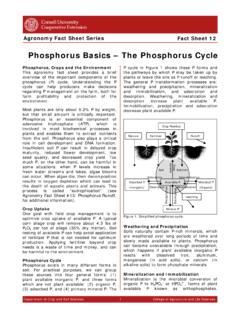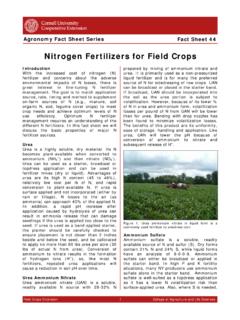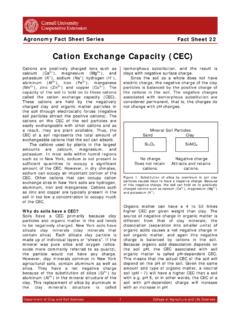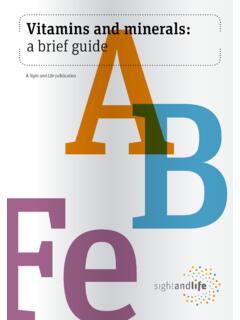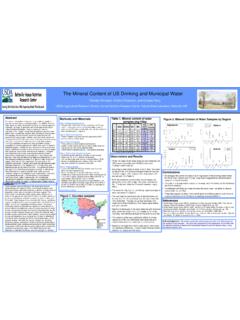Transcription of SOIL FERTILITY AND NUTRIENT MANAGEMENT
1 NRCCA soil FERTILITY & NUTRIENT MANAGEMENT Study Guide 10/26/2016 1 soil FERTILITY AND NUTRIENT MANAGEMENT Competency Areas Competency Area 1: Basic Concepts of Plant Nutrition .. 2 Competency Area 2: Basic Concepts of soil FERTILITY .. 3 Competency Area 3: soil Testing and Plant Tissue Analysis .. 8 Competency Area 4: NUTRIENT Sources, Analyses, Application Methods .. 18 Competency Area 5: soil pH and Liming .. 26 Competency Area 6: NUTRIENT MANAGEMENT Planning .. 32 2016 Authors/Instructors for soil FERTILITY and NUTRIENT MANAGEMENT o Quirine Ketterings, Professor, NUTRIENT MANAGEMENT Spear Program, Department of Animal Science, Cornell University. o Karl Czymmek, Senior Extension Associate, PRO-DAIRY Program, Department of Animal Science, Cornell University. o Doug Beegle, Professor, Department of Plant Sciences, Penn State University. o Joe Lawrence, Dairy Forage Systems Specialist, PRO-DAIRY Program, Department of Animal Science, Cornell University. With thanks to our past contributors: o Tom Buob, Extension Educator, University of New Hampshire Cooperative Extension.
2 O Patty Ristow, Extension Associate, NUTRIENT MANAGEMENT Spear Program, Department of Animal Science, Cornell University. Lead Editors: Nicole Smaranda, NRCCA Intern, and Quirine Ketterings, NRCCA Co-Chair. Last Updated 10-26-2016 NRCCA soil FERTILITY & NUTRIENT MANAGEMENT Study Guide 10/26/2016 2 Competency Area 1: Basic Concepts of Plant Nutrition 1. List the 17 elements essential for plant nutrition. NUTRIENT Macro/micro Uptake form Mobility in Plant 1 Carbon Macro CO2,H2CO3 2 Hydrogen Macro H+,OH-,H2O 3 Oxygen Macro O2 4 Nitrogen Macro NO3-,NH4+ Mobile 5 phosphorus Macro HPO4-2,H2PO4- Somewhat Mobile 6 Potassium Macro K+ Mobile (very) 7 calcium Macro Ca+2 Immobile 8 magnesium Macro Mg+2 Somewhat mobile 9 Sulfur Macro SO4- Mobile 10 Boron Micro H3BO3,BO3- Immobile 11 Copper Micro Cu+2 Immobile 12 Iron Micro Fe+2,Fe+3 Immobile 13 Manganese Micro Mn+2 Immobile 14 Zinc Micro Zn+2 Immobile 15 Molybdenum Micro MoO4- Immobile 16 Chlorine Micro Cl- Mobile 17 Nickel Micro Ni+2 Mobile 2.
3 Classify each essential elements as macronutrient or micronutrient. See Table 1. The macronutrients can also be grouped as primary nutrients (nitrogen, phosphorus and potassium) and the secondary nutrients ( calcium , magnesium and sulfur). This group of nutrients is used in large quantities. The micronutrients are used in much smaller quantities but equally essential. 3. Recognize the functions of N, P, and K in plants. o Nitrogen: found in chlorophyll, nucleic acids and amino acids; component of protein and enzymes. o phosphorus : an essential component of DNA, RNA and phospholipids which play critical roles in cell membranes; also plays a major role in the energy system (ATP) of plants. o Potassium: plays a major role in plant metabolism, and is involved in photosynthesis, drought tolerance, improved winter-hardiness and protein synthesis. 4. Distinguish each macronutrient as mobile or immobile in the plant. See Table 1. In shortage conditions, nutrients that are mobile in the plant will move to new growth areas so deficiency symptoms will first show up in the older leaves.
4 Nutrients that are immobile in the plant will not move to the new growth so deficiency symptoms show up in the new growth. NRCCA soil FERTILITY & NUTRIENT MANAGEMENT Study Guide 10/26/2016 3 5. List chemical uptake forms for each macronutrient. See Table 1. Take note: some of the nutrients are taken up in more than one form. 6. Describe how NUTRIENT demands change at different plant growth stages. In general, NUTRIENT needs increase as the plant grows through the seedling stage into the reproductive stage (silking and tasseling). For nitrogen, the rate of uptake increases rapidly between V8 (knee high typically) and R1 (silking). When plants are young and small, NUTRIENT need is low. As plants enlarge and start to grow rapidly, NUTRIENT needs increase dramatically. Competency Area 2: Basic Concepts of soil FERTILITY 7. Recognize the role of the following in supplying nutrients from the soil : A. soil solution B. Cation exchange sites C. Organic matter D. soil minerals E.
5 Plant residue o The soil solution is the liquid in the soil and plant nutrients dissolved in the soil solution can move into the plant as the water is taken up. o Cations (positively charged ions such as calcium , magnesium and potassium) are held on negatively charged exchange sites in the soil . Cation exchange capacity (CEC) is a measure of the amount of cations that can be held by the soil and released into the soil solution. Soils with a greater cation exchange capacity (see PO#10) are able to hold onto more nutrients. Organic matter contains nutrients that are released for plant uptake through microbial decomposition. o As soil minerals (clays, carbonates, etc.) weather (breakdown) they release nutrients for plant uptake. A good example of this is potassium. o As plant residues breakdown, the nutrients in them become available to growing plants. Nitrogen is typically the one we think of, but the other essential nutrients in plant residues will become available for plant uptake as well.
6 O The speed and degree of the breakdown of residues will depend on environmental factors such as moisture and temperature. Most nutrients are released as the organic molecules in the residue are broken down by microbes. However, some nutrients, like K, are not part of any organic molecules in residues and thus are released much more rapidly. 8. Describe the following NUTRIENT transformations and interactions: A. Mineralization B. Immobilization C. NUTRIENT uptake antagonism o Mineralization refers to the conversion of organic N sources (plant residues, manures, and biosolids) to inorganic N sources. This is accomplished by a wide variety of microorganisms. o Immobilization is the reverse of mineralization as this refers to the conversion of inorganic forms of nitrogen into organic forms, such as microbial cells and organic matter. NRCCA soil FERTILITY & NUTRIENT MANAGEMENT Study Guide 10/26/2016 4 o Mineralization and Immobilization occur at the same time. The net effect of these two processes is typically determined by the ratio of carbon to the nitrogen content in the organic material.
7 For example, a C:N ratio less than ~20 typically results in net mineralization of N and a C:N ratio greater than ~30 typically results in net immobilization of N. o NUTRIENT uptake antagonism refers to circumstances where, depending on soil conditions and NUTRIENT form and availability, plant uptake is weighted favorably toward some NUTRIENT (s) over others. 9. Describe how the processes of mass flow, diffusion, and root interception affect NUTRIENT uptake. o Mass flow of a NUTRIENT occurs when it is dissolved in the soil solution and flows with water into the plant. This is the major process for uptake of nitrogen, calcium and magnesium . o Diffusion is the movement of a NUTRIENT from an area of high concentration to one of lower concentration. Typically the NUTRIENT will move from the soil solution (high concentration) to the root surface (low concentration). This is an important process for phosphorus and potassium and is a key theory behind the use of banded or starter fertilizer.
8 O Root interception occurs when a root grows in to a fresh area or surface of clay or organic matter reducing the distance a NUTRIENT must diffuse and thus increasing absorption of the NUTRIENT . Root interception is extremely important for very immobile nutrients like P and thus having good soil conditions for root growth is essential for good P nutrition. 10. Describe how cation exchange capacity (CEC) influences NUTRIENT mobility and uptake. Cation exchange capacity (CEC) is a measure of the amount of cations (positively charged ions) that can be held by the soil . As the clay content, organic matter content and pH increase, the CEC will also increase. As CEC increases, so does the ability of the soil to hold nutrients. Since much of the plant uptake (and leaching) of nutrients comes from the soil solution, as the CEC increases, the nutrients in solution decrease and become less mobile in the soil . Having optimum levels of cations on the CEC and having low levels of non- NUTRIENT and potentially harmful cations such as Al on the CEC is important for supplying these essential NUTRIENT cations for plant uptake.
9 11. Distinguish each macronutrient as mobile or immobile in the soil and recognize difference in mobility depending on form. The mobility of nitrogen is dependent on the form it is in. If it is in the nitrate form (NO3-) it is very mobile with the soil water and can be easily leached. In the ammonium form (NH4+) it can be held on cation exchange sites and is not susceptible to leaching. phosphorus is typically immobile in the soil unless soil test levels rise above the soil s ability to bind it. calcium , magnesium and potassium are considered immobile in soil since they are held on cation exchange sites. Sulfur (as sulfate SO4- is an anion and not held on cation exchange sites) is mobile in most soils. 12. Describe how the following soil characteristics affect NUTRIENT uptake: A. Texture B. Structure C. Drainage/aeration D. Moisture E. pH F. Temperature NRCCA soil FERTILITY & NUTRIENT MANAGEMENT Study Guide 10/26/2016 5 o Texture is defined as the proportion of sand, silt and clay in the soil .
10 As the clay content increases, so does the CEC, resulting in a greater ability to hold nutrients. Soils with more sand and less clay have lower CECs and cannot hold as many cations. Since sandy soils also have large pore spaces, leaching of nutrients is greater than on a soil with more silt and clay. o soil structure is defined as the arrangement of soil particles into aggregates. Good soil structure is represented by significant aggregation. This allows for optimal root growth and water and NUTRIENT access for any given soil . Destruction of good structure, by compaction or tillage can result in an increase in runoff since water cannot move as readily down through the soil profile. o Under poor drainage conditions, nitrate nitrogen can be lost through denitrification. With excessively drained soils (sandy) leaching losses are more important. Some nutrients like iron and manganese are more soluble under very wet or flooded conditions. o soil moisture is very important for root growth, so adequate moisture will improve uptake of nutrients by diffusion and root interaction.
